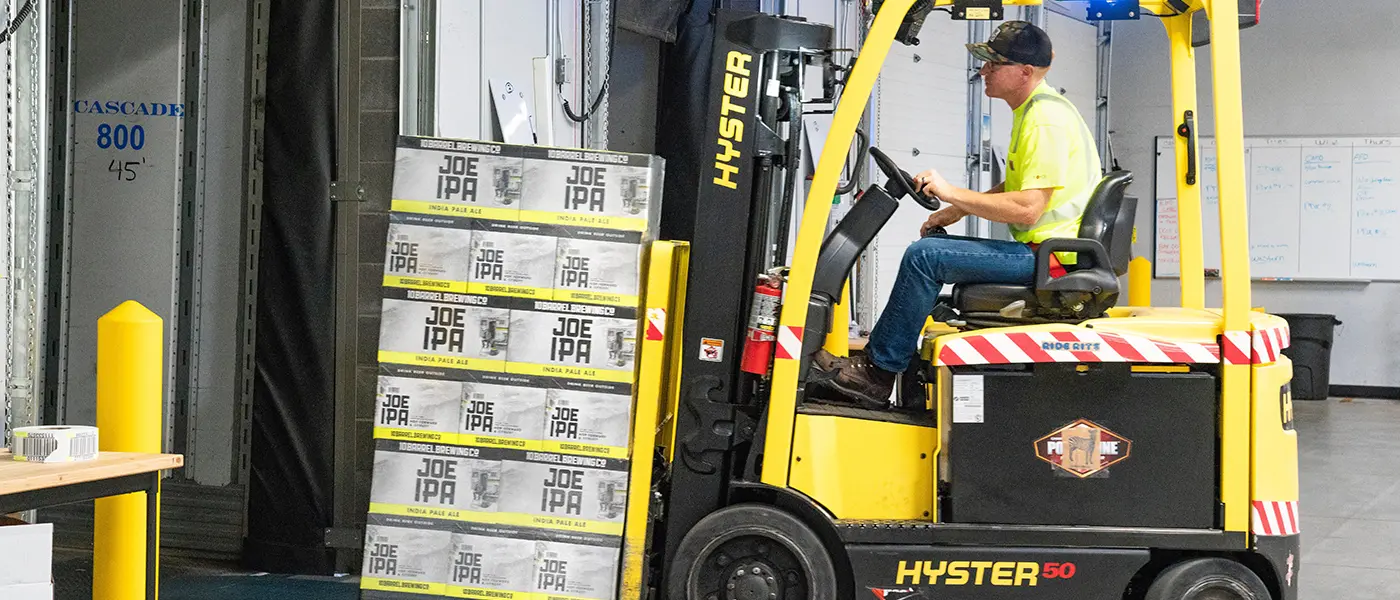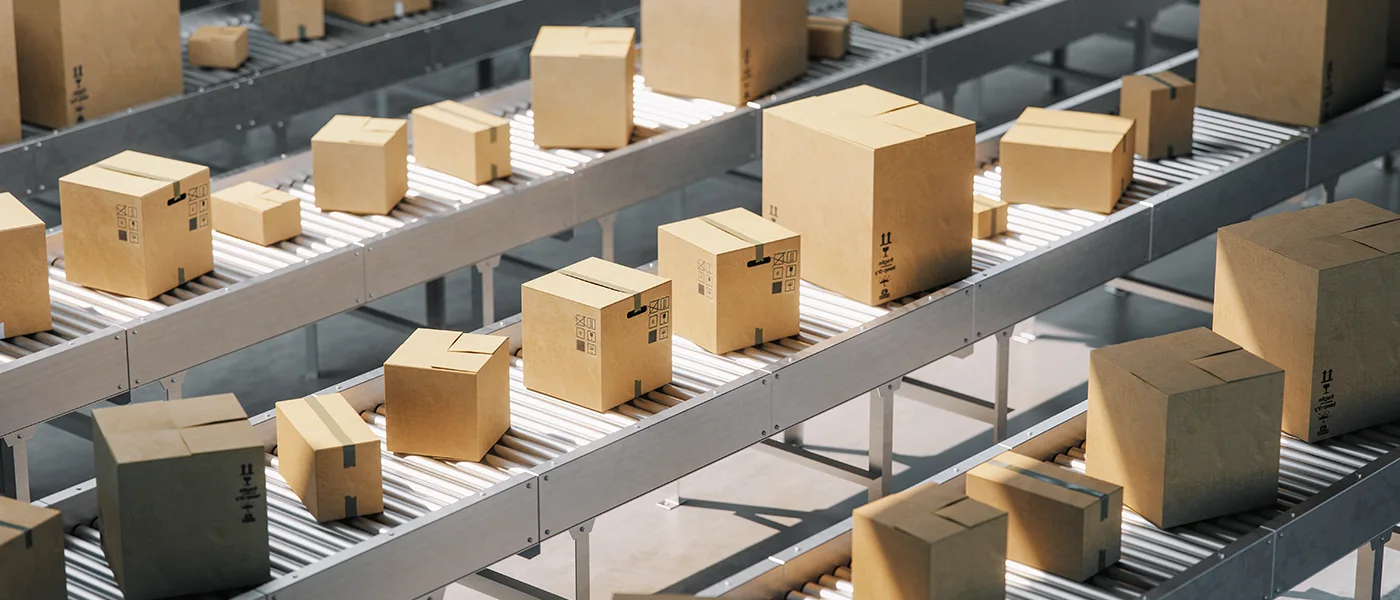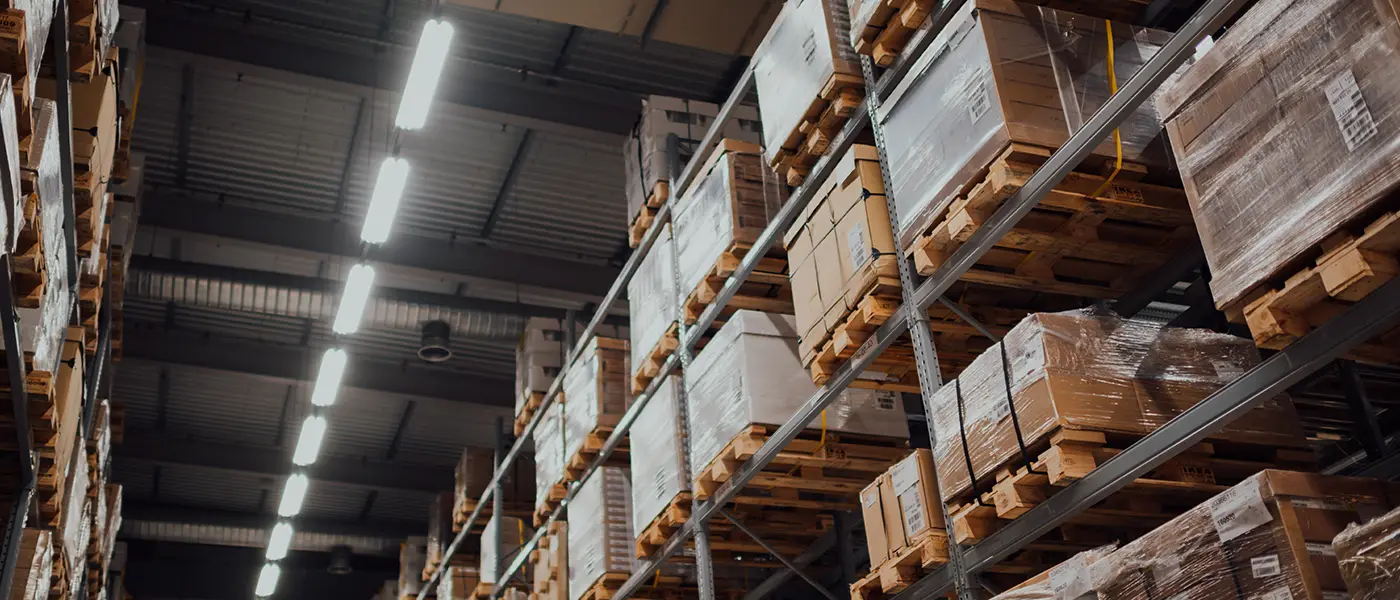Welcome to the world of e-commerce logistics management. In this guide, we will explore the essential functions that govern the movement and storage of goods in the supply chain. From inbound, outbound and reverse logistics management to warehousing, order fulfillment, and inventory control, logistics management plays a crucial role in helping e-commerce businesses plan, execute, and optimise their processes efficiently.
Effective logistics management ensures that goods flow smoothly throughout the supply chain, enabling businesses to meet customer demands promptly and accurately.
Throughout this guide, we will explore the challenges e-commerce businesses face in logistics management and provide you with practical best practices and actionable insights to overcome them. Whether you are seeking to streamline your order fulfillment process, enhance inventory control, or improve overall logistics operations, this guide will equip you with the knowledge and tools you need to succeed.
Join us as we delve into the world of e-commerce logistics management, where efficiency and customer satisfaction go hand in hand. Discover how implementing effective logistics strategies can help your business thrive in the fast-paced e-commerce industry.
What is Logistics Management?
Logistics management encompasses the governance and coordination of various supply chain functions to facilitate the movement and storage of goods. In the context of e-commerce, it involves the seamless management of inbound and outbound transportation, warehousing, order fulfillment, inventory control, and more.
In simple terms, logistics management ensures that the right products are available at the right place and time while optimising costs and maintaining customer satisfaction. It requires meticulous planning, execution, and monitoring of processes to achieve operational efficiency and meet the dynamic demands of the e-commerce industry.
Why Is Logistics Management Important?
Logistics is one of the most essential elements that contribute to a successful supply chain that helps boost the sales and profits of a company or any e-commerce business that deals with the production, warehousing, shipment and delivery of products.
The top reasons why logistics management is integral to the supply chain are listed below:
Boosts Efficiency
Not only does it help create visibility in the supply chain system of a company, but it can also improve production efficiency and take it a step further. Business management uses the analysed data or the tracked movements of goods and materials in and out of an organisation from a transportation management system to optimise processes and avoid potential disruptions.
Guarantees Seamless Delivery
Logistics management is integral to successfully delivering products at the right place and at the right time. Professionally organised logistics also choose an expert team of professionals who help ensure fast and safe shipment, warehousing and delivery of products to the respective customers.
Integral for a Successful Supply Chain Process
Logistics is one of the most essential elements of a successful supply chain that boosts sales and profits of organisations dealing with product production, warehousing, shipment and delivery. Additionally, reliable logistics services can be highly beneficial for a business as it helps in boosting a business’s value and helps in keeping up a positive public image.
Ensures Best Customer Satisfaction
The customers make or break a company or product idea. Customer satisfaction is the key to a business’s ultimate success. A reliable logistics management helps plan out good strategies that help provide better services to meet customer demand. A company can also get repeat orders via creating goodwill for the supplier for each delivery that is met on time.
Logistics Management Objectives
The primary objectives of logistics management in the e-commerce industry are to ensure smooth operations, optimise resource utilisation, and meet customer demands efficiently. Here are the key objectives that businesses strive to achieve:
![E-commerce Logistics Management: Definition, Objectives, Challenges, Best Practices & Actionable Insights [+Templates] 2 Logistics Management Objectives](https://golocad.com/wp-content/uploads/2023/07/Logistics-Management-Objectives.webp)
- Timely Delivery: Logistics management aims to ensure that products are delivered to customers in a timely manner, meeting their expectations for fast and reliable shipping. This objective involves effective coordination of transportation, warehouse operations, and order fulfillment processes.
- Cost Optimisation: Logistics management seeks to minimise costs associated with transportation, warehousing, inventory holding, and order fulfillment. By optimising routes, consolidating shipments, and implementing efficient inventory management practices, businesses can reduce logistics expenses and improve profitability.
- Inventory Efficiency: Managing inventory effectively is crucial for logistics management. The objective is to strike a balance between having enough stock to meet customer demands without excessive carrying costs or risk of stockouts. Businesses can achieve optimal inventory levels by implementing accurate demand forecasting, efficient order management, and real-time inventory tracking.
- Supply Chain Visibility: Logistics management aims to provide visibility and transparency across the supply chain. The objective is to have real-time insights into inventory levels, order statuses, and transportation tracking. This visibility enables businesses to make informed decisions, identify bottlenecks, and proactively address issues to maintain smooth operations.
- Sustainability: With increasing environmental concerns, logistics management also focuses on sustainability objectives. Businesses aim to reduce carbon emissions, optimise fuel consumption, and adopt eco-friendly practices in transportation and warehousing. This objective aligns with corporate social responsibility and enhances the brand’s reputation.
- Continuous Improvement: Logistics management strives for ongoing improvement in processes and operations. The objective is to identify areas for enhancement, implement best practices, and leverage technological advancements to drive efficiency, reduce costs, and deliver better customer experiences.
Key Activities in Logistics Management Process
Logistics management involves a range of key activities crucial for the efficient movement and storage of goods in the e-commerce supply chain. Here are the essential activities involved:
![E-commerce Logistics Management: Definition, Objectives, Challenges, Best Practices & Actionable Insights [+Templates] 3 Key Activities in Logistics Management](https://golocad.com/wp-content/uploads/2023/07/Key-Activities-in-Logistics-Management.webp)
Inbound Transportation
Coordinating the movement of goods from suppliers or manufacturers to the e-commerce business’s facilities. This includes managing transportation modes, negotiating freight rates, scheduling pickups, and tracking inbound shipments.
Outbound Transportation
Managing the transportation of goods from the e-commerce business’s facilities to customers. This involves selecting carriers, optimising delivery routes, arranging last-mile delivery, and tracking outbound shipments to ensure timely and accurate deliveries.
Warehousing
Strategically planning and managing warehouse operations to facilitate efficient storage and retrieval of goods. This includes organising inventory, implementing proper shelving systems, employing efficient picking and packing processes, and maintaining accurate stock records.
Order Processing
Handling customer orders from the time they are received until they are fulfilled and shipped. This involves order verification, inventory allocation, order prioritisation, and coordinating with various departments to ensure timely processing and accurate order fulfillment.
Inventory Management
Managing inventory levels to meet customer demands while minimising carrying costs. This includes inventory tracking, demand forecasting, stock replenishment, implementing safety stock levels, and conducting regular audits to ensure accuracy.
Packaging and Labelling
Ensuring appropriate packaging and labelling of products for safe transportation and accurate delivery. This involves selecting suitable packaging materials, complying with regulatory requirements, and clearly labelling packages with necessary information.
Reverse Logistics
Managing the return and disposal of products, including customer returns, defective items, and excess inventory. This involves establishing return policies, processing returns efficiently, refurbishing or disposing of returned products, and managing associated documentation and accounting.
Technology and Systems
Leveraging technology solutions and systems to streamline logistics operations. This includes using warehouse management systems, transportation management systems, inventory tracking software, and data analytics tools to gain visibility, automate processes, and make data-driven decisions.
Supplier and Carrier Management
Collaborating with suppliers and managing relationships with carriers and logistics service providers. This involves negotiating contracts, ensuring compliance with service-level agreements, monitoring performance, and continuously evaluating and optimising partnerships.
Continuous Improvement
Proactively seeking opportunities to enhance logistics processes and performance. This includes conducting regular performance evaluations, gathering customer feedback, identifying areas for improvement, and implementing best practices and process refinements to drive efficiency and customer satisfaction.
By managing these key activities effectively, e-commerce businesses can optimise their logistics operations, meet customer expectations, and gain a competitive edge in the dynamic e-commerce landscape.
Logistics Management vs. Supply Chain Management
Logistics and Supply Chain Management are two terms that have frequently interchangeable usage in the business world, but they refer…
Logistics Management Structure
The logistics management structure is designed to create an effective framework that supports the achievement of business goals. While there is no one-size-fits-all structure, it should be customised to align with the company’s specific needs and enable the implementation of the business strategy.
The logistics management structure typically encompasses several key departments or segments, including:
- Production: This department focuses on the manufacturing or assembly of goods and plays a crucial role in determining production schedules and ensuring efficient utilisation of resources.
- Purchase: The purchase department is responsible for procuring raw materials, components, and finished goods from suppliers, negotiating contracts, and managing vendor relationships.
- Sales: The sales department handles customer orders, manages sales channels, and coordinates with other departments to ensure timely order processing and delivery.
- Human Resources: The human resources department is responsible for recruiting, training, and managing the workforce involved in logistics operations. They also handle employee development, performance management, and workplace policies.
- Finance: The finance department oversees financial aspects related to logistics management, including budgeting, cost control, financial analysis, and ensuring compliance with financial regulations.
The logistics management structure can be categorised into different organisational designs based on the hierarchy of powers:
- Line (Linear) Structure: This structure is common in small-scale organisations where the business owner leads a single management level. Decisions are made through direct command authority, and there is a clear chain of command.
- Staff Structure: In this design, staff services support line managers by providing expert decision-making in their respective departments. These staff members are specialists in various fields and provide indirect professional management support.
- Combined Structure: A combined organisational structure in logistics is a hybrid approach that incorporates elements of both line and staff structures. It balances the direct command authority of line managers with the specialised expertise of staff members.
The choice of logistics management structure depends on the company’s size, nature of operations, and strategic goals. It should promote efficient communication, collaboration, and decision-making among different departments, enabling smooth logistics operations and supporting the business’s overall success.
Different Types of Logistics Management Structures
Logistics management structures can vary based on an organisation’s specific needs and characteristics. Here are some common types of logistics management structures:
Functional Structure
In this type of structure, logistics functions are grouped based on their specialised areas, such as transportation, warehousing, inventory management, and customer service. Each functional area has its own department or team responsible for managing the related logistics activities. This structure allows for focused expertise in each area and promotes efficiency within specific functions.
Divisional Structure
A divisional logistics management structure is organised around different product lines, geographic regions, or customer segments. Each division has its own dedicated logistics team responsible for managing the logistics activities specific to that division. This structure allows for better alignment with the unique requirements of each division and facilitates targeted logistics strategies.
Matrix Structure
A matrix logistics management structure combines both functional and divisional structures. In this approach, logistics functions are organised by specialisation while also having dedicated teams or departments for specific divisions or product lines. This structure promotes both functional expertise and divisional alignment, enabling effective coordination and collaboration across different areas of the organisation.
Centralised Structure
A centralised logistics management structure consolidates logistics functions under a central authority or department. This structure enables standardised processes, centralised decision-making, and better control over logistics activities. It can be particularly beneficial for organisations with a single, centralised distribution centre or a strong emphasis on cost control and efficiency.
Decentralised Structure
A decentralised logistics management structure grants more autonomy to different business units, branches, or regions in managing their logistics activities. Each unit or region has its own logistics team responsible for local operations and decision-making. This structure allows for greater flexibility and responsiveness to local market conditions and customer needs.
Hybrid Structure
A hybrid logistics management structure combines elements of different structures to suit an organisation’s specific requirements. It may involve a combination of centralised and decentralised decision-making, functional and divisional responsibilities, or other customised arrangements. Organisations with diverse operations or complex logistics requirements often adopt this structure.
Again, the choice of a logistics management structure depends on factors such as the organisation’s size, scope of operations, industry characteristics, and strategic objectives. It is essential to consider the specific needs and goals of the organisation to determine the most suitable structure that promotes effective logistics management and supports overall business success.
The Importance of Distribution Networks in Logistics Management
In logistics management, the distribution network plays a vital role in ensuring the efficient flow of goods from manufacturers to customers. It encompasses the interconnected transportation systems, storage facilities, and processes that facilitate the receipt and delivery of goods within the supply chain. Let’s delve into some crucial aspects of the distribution network in deciding the success of a logistics management engine:
Developing an Efficient Distribution Network
Creating an efficient distribution network is crucial for the success of a company. It involves strategic planning to enable products to reach customers quickly and cost-effectively while maximising profit margins. This includes optimising the network design, determining the optimal number and location of warehouses or distribution centres, and establishing effective transportation routes.
Involving a Far-Reaching Distribution Network
The complexity of the distribution network depends on the product and the target customer’s location. Manufacturers typically have their own distribution network to serve wholesalers, who, in turn, have their own networks to distribute to retailers. The final link in the supply chain often involves selling goods through retail stores owned by the retailers. Alternatively, a simpler supply chain may include shipping products from the manufacturer to its distribution network before reaching customers.
Proximity to the Consumer
The location of distribution sites in the network is critical. It should be strategically positioned to ensure proximity to the target consumer base and optimise transportation and delivery efficiency. The quality of infrastructure and geographical factors are essential considerations when selecting distribution site locations. Each site in the distribution network must be equipped to handle storage, handling, and transportation functions effectively.
Planning for Critical Needs
Planning is essential for determining the requirements of workers, equipment, IT systems, and transportation fleets within the distribution network. Companies need to evaluate whether a hub-and-spoke distribution network or a decentralised network is more profitable for their business. This involves considering factors such as order volume, customer demand patterns, and geographic coverage.
By focusing on developing an efficient distribution network, your logistics management can effectively streamline the movement of goods and enhance customer satisfaction.
Always remember that a well-designed and optimised distribution network contributes to the overall success of the supply chain and helps businesses gain a competitive edge in the market.
What is Logistics Management Control?
Logistics management control is critical to effectively managing and optimising logistics processes. It involves the planning, monitoring, and managing logistics activities to achieve specific goals and improve overall efficiency. By implementing control measures, organisations can align logistics operations with strategic objectives and make informed decisions based on real-time data and analysis.
The primary purpose of logistics management control is to ensure that logistical planning is measurable and supports the achievement of set targets. It involves establishing key performance indicators (KPIs) and implementing performance measurement systems to track and assess the performance of logistics activities. This allows organisations to identify areas of improvement, address bottlenecks, and enhance logistical efficiency.
Organisations can gain visibility into their logistics operations through logistics management control and monitor key aspects such as transportation, warehousing, inventory management, order fulfillment, and customer service. By collecting and analysing relevant data, organisations can identify trends, evaluate performance against targets, and take proactive measures to optimise logistics processes.
Effective logistics management control also involves the integration of logistics into strategic corporate planning. This means that logistics considerations are taken into account when formulating and executing overall business strategies. By aligning logistics with the broader organisational goals, organisations can ensure logistics activities support and contribute to achieving strategic objectives.
To establish logistics management control, organisations implement various tools and techniques. These may include:
- Key Performance Indicators (KPIs): Organisations define and track specific KPIs related to logistics, such as on-time delivery, order accuracy, inventory turnover, and transportation costs. KPIs provide measurable targets and benchmark to evaluate logistics performance.
- Performance Measurement Systems: Organisations utilise performance measurement systems to collect relevant data, monitor logistics activities, and assess performance against established KPIs. This may involve the use of software solutions, data analytics, and regular reporting.
- Continuous Improvement Initiatives: Logistics management control encourages a culture of continuous improvement. Organisations regularly analyse performance data, identify areas for enhancement, and implement measures to optimise logistics processes and achieve greater efficiency.
- Technology and Automation: The adoption of technology and automation plays a crucial role in logistics management control. Organisations leverage advanced systems and software solutions for transportation management, warehouse management, inventory control, and real-time tracking to enhance visibility, automate processes, and enable data-driven decision-making.
Organisations can effectively monitor, evaluate, and optimise their logistics operations by implementing logistics management control. It enables them to proactively address challenges, improve efficiency, and align logistics activities with strategic objectives, ultimately contributing to the organisation’s overall success.
Common Challenges in E-commerce Logistics Management
E-commerce logistics management comes with its own challenges that businesses must navigate to ensure smooth and efficient operations. Here are some common challenges faced by e-commerce businesses in logistics management:
![E-commerce Logistics Management: Definition, Objectives, Challenges, Best Practices & Actionable Insights [+Templates] 4 Common Challenges in E-commerce Logistics Management](https://golocad.com/wp-content/uploads/2023/06/Common-Challenges-in-E-commerce-Logistics-Management.webp)
- Scalability: As e-commerce businesses grow and experience increasing order volumes, logistics operations must scale accordingly. Managing a larger volume of e-commerce orders, coordinating with multiple suppliers and carriers, and maintaining timely deliveries can become more complex and challenging. Scaling logistics processes and infrastructure becomes crucial to meet the growing demands of the business.
- Last-Mile Delivery: The final leg of delivery, known as the last mile, presents unique challenges. Delivering packages to individual customers in diverse locations requires efficient route planning, effective communication with drivers, and overcoming obstacles such as traffic congestion or inaccessible delivery addresses. Ensuring timely and accurate last-mile deliveries is essential for customer satisfaction.
- Poor Inventory Management: Balancing inventory levels is a continuous challenge in e-commerce logistics. Businesses need to maintain sufficient stock to meet customer demands while avoiding overstocking, which ties up capital or understocking, leading to stockouts. Accurate demand forecasting, real-time inventory tracking, and proactive inventory replenishment strategies are crucial to optimise inventory levels.
- Inefficient Returns Management: E-commerce businesses often face higher product return rates than traditional retail. Managing returns efficiently involves establishing clear return policies, streamlining the returns process, inspecting returned items, and processing refunds or replacements promptly. Effective returns management is essential for customer satisfaction and maintaining a healthy bottom line.
- Cross-Border Logistics: International e-commerce introduces additional complexities in logistics management. Cross-border shipping involves navigating customs procedures, complying with international regulations, and managing longer transit times. Businesses must account for potential delays, ensure proper documentation, and choose reliable cross-border logistics partners to facilitate smooth international shipments.
- Technology Integration: Adopting and integrating technology solutions is crucial for efficient logistics management. However, integrating various systems, such as inventory management, order processing, and transportation management, can be challenging. Businesses need to ensure seamless data exchange between systems, implement user-friendly interfaces, and provide adequate training to employees to maximise the benefits of technology in logistics operations.
- Data Security: With the increasing reliance on digital systems and data exchange, protecting sensitive information and ensuring data security is paramount. E-commerce businesses must implement robust cybersecurity measures, secure customer data, and comply with data protection regulations. Protecting the integrity and confidentiality of logistics-related data is essential to maintain trust with customers and partners.
- Poor Supply Chain Visibility: Lack of visibility across the supply chain can hinder effective logistics management. Businesses need real-time insights into inventory levels, order statuses, and transportation tracking to make informed decisions and address potential bottlenecks. Implementing technologies such as tracking systems, data analytics tools, and collaboration platforms can enhance supply chain visibility and enable proactive decision-making.
- Fighting Customer Expectations: The e-commerce landscape is highly competitive, and customer expectations continue to rise. Customers expect fast and reliable deliveries, transparent tracking, and hassle-free returns. Meeting and exceeding customer expectations requires efficient logistics operations, proactive communication, and a customer-centric approach throughout the order fulfillment process.
- Sustainability Challenges: As sustainability becomes a growing concern, e-commerce businesses face the challenge of implementing environmentally friendly logistics practices. This includes optimising transportation routes to minimise carbon emissions, adopting eco-friendly packaging materials, and exploring alternative energy sources for transportation. Balancing sustainability with operational efficiency is crucial for businesses aiming to reduce their environmental impact.
Expert Actionable Insights for Logistics Management (From Team Locad)
In the fast-paced world of logistics management, having access to expert actionable insights can make a significant difference in optimising your logistics operations. To help you navigate the challenges and drive efficiency, Team Locad is here to provide you with valuable insights gained from their extensive experience in the industry.
- Embrace Technology Solutions: Leverage advanced technology such as warehouse management systems, transportation management systems, and data analytics tools to streamline your logistics processes, gain real-time visibility, automate tasks, and make data-driven decisions.
- Prioritise Supply Chain Visibility: Establish a robust system for tracking inventory, order statuses, and transportation movements. This visibility enables you to proactively identify bottlenecks, address issues promptly, and make informed decisions to maintain smooth operations.
- Implement Efficient Order Fulfillment Processes: Optimize your order processing, inventory allocation, and picking and packing operations to ensure accurate and timely order fulfillment. This involves efficient order verification, proper inventory management, and coordination across departments.
- Focus on Demand Forecasting: Implement accurate demand forecasting techniques to optimise inventory levels, reduce stockouts, and minimise carrying costs. Understanding customer demand patterns can enhance inventory management and maintain high service levels.
- Collaborate with Reliable Partners: Build strong relationships with trusted suppliers, carriers, and logistics service providers. Effective collaboration and communication help ensure reliable and timely delivery of goods while optimising costs and maintaining customer satisfaction.
- Continuous Process Improvement: Regularly evaluate your logistics processes, gather customer and stakeholder feedback, and identify improvement areas. Implement best practices, refine workflows, and embrace innovative solutions to drive efficiency and enhance customer experiences.
- Sustainability and Green Practices: Incorporate sustainable practices into your logistics operations. Reduce carbon emissions, optimise fuel consumption, and explore eco-friendly packaging and transportation options. Embracing sustainability aligns with corporate social responsibility and enhances your brand reputation.
Team Locad is a leading logistics solutions provider in the Asia Pacific region, specialising in e-commerce logistics and fulfillment management. With our deep industry knowledge and expertise, we offer tailored strategies and innovative solutions to optimise your logistics operations and drive business growth.
Partner with Locad today to unlock the full potential of your logistics management and achieve operational excellence in the dynamic e-commerce landscape.





